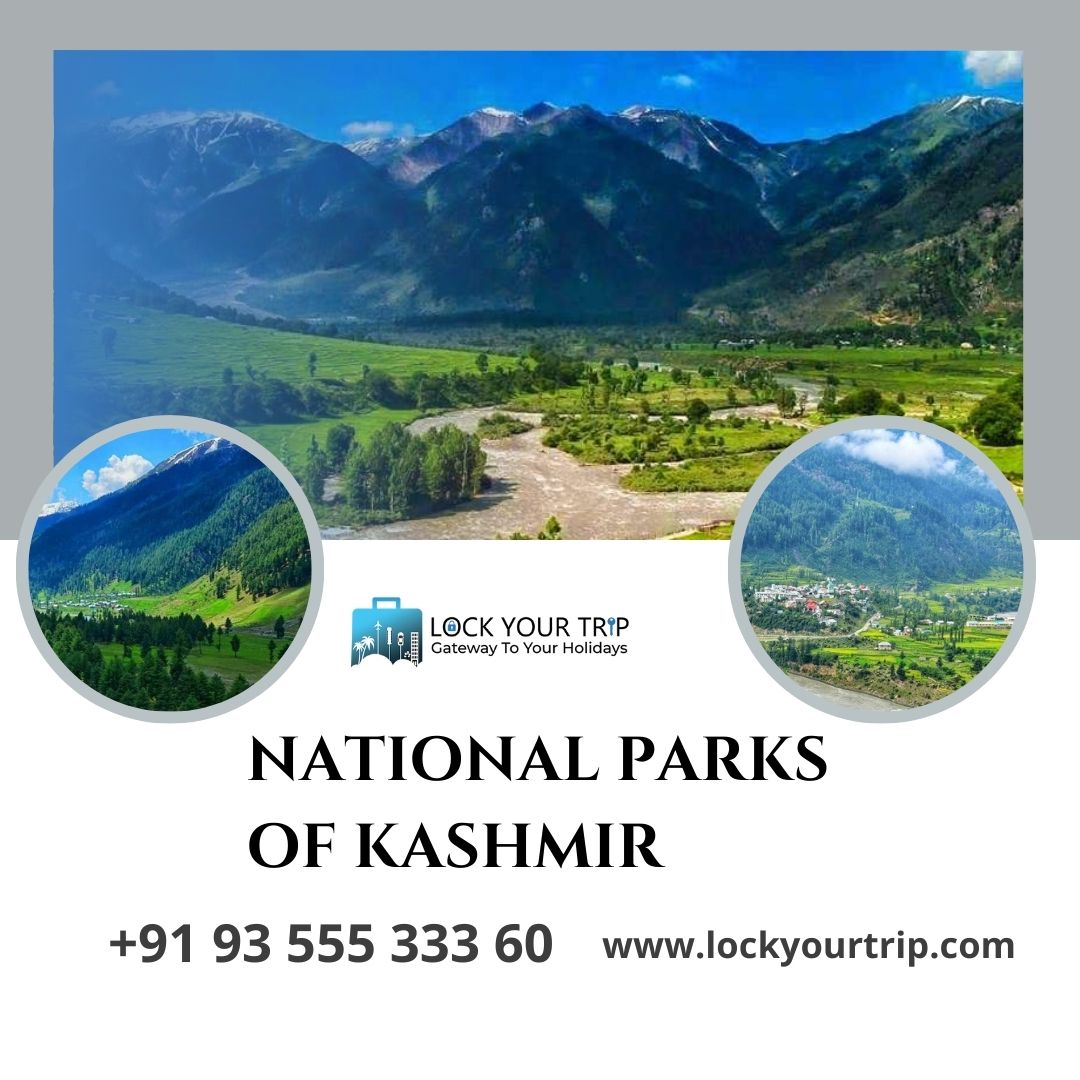Introduction:-
Kashmir is a well-liked travel destination because of its stunning scenery and abundant biodiversity. Not many people are aware of Dal Lake’s other attractions outside the Shikara ride. The valley’s national parks of Kashmir ecosystem is highly diverse, with broad-leaved forests at lower elevations, coniferous woods, and forests with Chir Pines. Present Kashmir as a place of unmatched ecological diversity and natural beauty. The summer months of April through October are the best times to visit the national parks in Kashmir. Thus, April to October would be the best time.
Come along on an unforgettable journey Travel with Lock Your Trip as we pack your itinerary with the amazing activities available in the National parks of Kashmir visits!
“The Top 5 National Parks in Kashmir”
Dachigam National Park:-
The varied terrain, which varies from thick jungle to alpine mead, creates the ideal habitat for a wide diversity of animals,
including leopards and musk deer. Despite challenges in National Parks in Kashmir like habitat downturn,
Dachigam has experienced valued care endeavors, particularly in the gate money of the Hangul population.
The prime purpose of Dachigam’s founding National Parks in Kashmir was to ensure that Srinagar City would have clean drinking water.
It had been a guarded area since 1910 when it was declared a national park in 1981. The most well-known inhabitant of the park is the hangul or Kashmir stag.
Hemis National Park:-
India’s Ladakh region is home to the high-elevation Hemis National Park. This region is well-known worldwide for its snow leopard population,
with what is thought to be the largest concentration of national parks in Kashmir among all protected areas worldwide. Outside the Changthang Wildlife Sanctuary northeast of Hemis and the projected Tso Lhamo Cold Desert Conservation Area in North Sikkim India’s guarded area inside the Palearctic region is called Hemis National Park. Hemis National Park a vast area created in 1981 protects the eastern part of Kashmir. Hemis is well known for its distinct biodiversity, where the rare snow leopard reigns king.
Kishtwar National Park :-
The Kishtwar High Altitude National Park, which covers an area of 2190.50 square km and offers a natural habitat to several species of mammals and birds, National Park of Kashmir. Kishtwar has a unique position in Jammu and Kashmir. The sanctuary ranges in altitude from 1700 to 4800 m. This Overview of the National Park of Kishtwar. Uncommon species and diversified environments. Community engagement and conservation efforts. The park’s ongoing study provides important insights into the biodiversity of the area, directing future conservation efforts. Constant research in Kishtwar helps to shape conservation plans by providing important insights into the region’s biodiversity.
Kazinag National Park :-
Following the Wild Life Protection Act of 1972 Kazinag National Park is a national park located in the Baramulla district of the Indian Union territory of Jammu and Kashmir. In UT of J&K, it is the fourth national park after Kishtwar, Dachigam, and City Forest National Parks. The Kazinag National Park is situated in Kashmir’s northern area.
Since its establishment in 1905 in response to the sharp reduction in the Indian rhinoceros population, Kaziranga has been a model of success for conservation.
5.Salim Ali National Park :-
Part of Srinagar, the park serves as a significant migratory bird habitat. The park’s Hokersar Wetland is a popular site for birdwatchers, with different types of drawings of a wide variety of avian species. The Dachigam National Park, different types of Kishtwar National Park, and Salim Ali National Park are the three national parks in Kashmir. There are also several places to stay in the region. This National Parks of Kashmir space was further modified into the Royal Springs Golf Course between 1998 and 2001.
Conservation Issues and Efforts in Kashmir’s National Parks:-
The World Wildlife Fund WWF and the National Parks of Kashmir IUCN helped the Jammu Kashmir governments establish a project for the safeguarding of the Hangul word and its habitat in the 1970s. Kashmir’s National Parks are essential to maintaining the region’s distinctive wildlife and flora. This article examines the difficulties and actions made to preserve the natural resources found in Kashmir’s national parks.
“Conservation Challenges”
Habitat degradation:-
In the 20th century, the population of this species has drastically decreased, raising concerns about its survival. The existence of the Kashmiri deer species is seriously threatened by several factors, chiefly industrialization and widespread human influence. National Parks of Kashmir Natural habitats within national parks are degrading as a result of human activities like logging, agriculture, and infrastructural development.
Read More-Explore the Enchanting Beauty of Manali with Tour Packages
Climate Change:-
The National Parks in Kashmir Jhelum River’s tributaries, which typically irrigate the paddy fields of southern Kashmir, are now dry near Pulwama’s Lelhar hamlet. Variations in temperature and precipitation can affect plant and animal species distribution and survival. Due to a lack of water, the once-luxurious green field has become desolate.
Poaching and Wildlife Trade:-
To carry out the Jammu and Kashmir Wildlife Act 1978, which protects the state’s wildlife, flora,
and fauna as well as management of its protected areas, the Department of Wildlife Protection of the Jammu & Kashmir Government was established in 1978.
The desire for exotic animals and their body parts drives the wildlife trade, which puts further strain on already vulnerable populations.
The National Board of Wildlife’s guidelines for the management and conservation of wildlife, the Department of Wildlife Conservation,
Jammu & Kashmir, is working to meet and exceed national and international scientific standards.
Water Pollution:-
The Kashmir Valley is well known worldwide for its stunning array of lentic and lotic freshwater bodies, including lakes, rivers, ponds, springs, and streams, in addition to its natural beauty.
In addition to being important for ecological, socioeconomic, and cultural heritage, these freshwater bodies serve as the main source of income and support the growth of the local economy. Water pollution harms aquatic life and can have a domino effect on the environment as a whole.
“Initiatives for Conservation”
Water Quality Management:-
The start of the State Water Resources Regulatory Authority to regulate water resources, ensure wise, equitable, and sustainable management, allocation, and use of water resources, fix rates for water use and matters related thereto or incidental thereto the measurement, construction, control, and management of works relating to water storage, maintenance and protection water supply, water supply, drainage, flood control as well as prevention the improvement of water flow the protection and improvement of the physical integrity of water courses, lakes, and springs the safety and watch of dams.
Participation of the Community:-
Putting in place initiatives to combat and eradicate invasive species, encouraging biodiversity-friendly land management techniques, and replanting native plants. Identifying and addressing the spread of invasive species by routine surveying. Participation in the Community.
Conclusion:-
To ensure that the national parks in Kashmir remain ecologically intact for the future, Lock Your Trip locally given complete information on our website. Collaboration between governmental and non-governmental organizations is essential. The National Parks of Kashmir face numerous as well as intricate conservation issues. The Himalayan ecosystem’s delicate balance is preserved and endangered species. These are given sanctuary by the National Parks of Kashmir, which act as protectors of the region’s rich biodiversity.











